Today, lets learn how to create an interesting chart. This, called as network chart helps us visualize relationships between various people.
Demo of interactive network chart in Excel
First take a look at what we are trying to build.
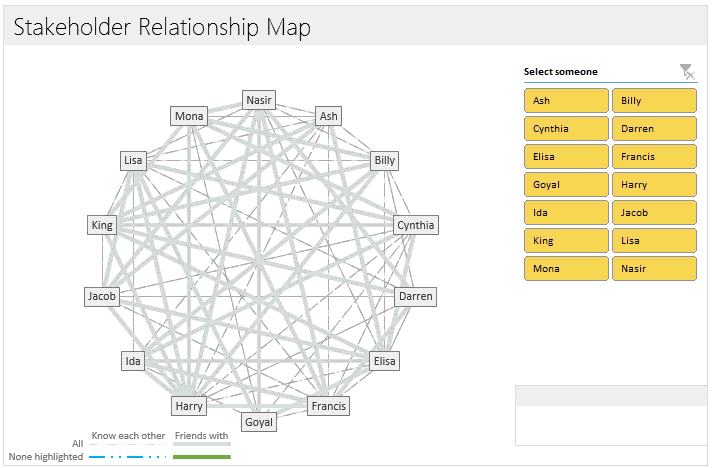
Looks interesting? Then read on to learn how to create this.
Note: thanks to Hans whose email question inspired me to create this chart.
Tutorial to create interactive network chart in Excel
Note: This tutorial requires intermediate-to-advanced Excel knowledge. So if you are beginner, learn the basics & advanced concepts first and then comeback for this.
In order to create this chart in Excel, we need to first understand various ingredients of it.
As you can see, the chart contains these parts:
- A set of dots, each representing one stakeholder
- A set of grayish thick & dotted lines representing all relationships between people.
- A set of green thick & blue dotted lines representing relationships for the selected person.
- A slicer for person selection (can be replaced with list box or clickable cells in Excel 2007 or below)
- Summary statistics of the selected person
Getting started with the relationship data
To simplify our tutorial, lets assume we are talking about relationships between just 4 people, named Ash, Billy, Cynthia & Darren.
Our relationship matrix looks like this:
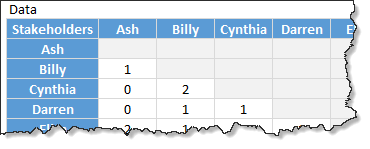
- 0 means no relationship
- 1 means weak relationship (for example: Ash & Billy just know each other)
- 2 means strong relationship (for example: Cynthia & Billy are friends)
The downloadable workbook is created to take up to 20 stakeholders.
Geometry of the network chart
If we draw the relationships between these 4 people (Ash, Billy, Cynthia & Darren) on a paper, it would look like this:
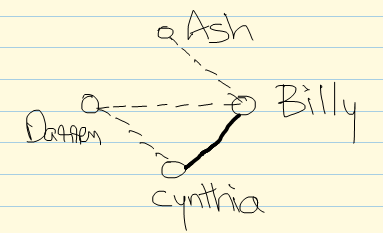
The 2 things we need to determine are,
- The location of dots (where person names are printed)
- The lines (starting & ending point of lines)
Plotting dots around circle
We need to plot our dots in such a way that gap between each dot is same. This will create a balanced chart.
What shape satisfies our need for such equal gaps? A circle of course.
Hey wait, I don’t see a circle in the chart you have shown…?
Thats right. We don’t need to draw a circle. We just need to plot dots around it.
- So we have 4 stakeholders, we need 4 dots
- If we have 12 stakeholders, we need 12 dots
- If we have 20, we need 20 dots.
Assuming the origin of our circle is (x,y), radius is r and theta is 360 divided by number of dots we need,
the first dot (x1,y1) on the circle will be at this position:
x1 = x + r*COS(theta)
y1 = y + r*SIN(theta)
[Related: How to create a spoke chart in Excel]
Once all the dots are calculated & plugged in to an XY chart (scatter plot), lets move on.
Plotting the lines
Lets say we have n people in the network. So that means, each person can have a maximum of n-1 relationships.
So the total possible lines in our chart are n*(n-1)/2
We need to divide it by 2 as if A knows B, then B knows A too. But we need to draw only 1 line.
My network chart template is set up to work with up to 20 people. So that means, the maximum number of lines we can have will be 190
Each line requires a separate series to be added to the chart. That means, we need to add 190 series of data just for 20 people. And that satisfies only one type of line (either dotted or thick). If we want different lines based on type of relationship, then we need to add another 190 series.
This is painful & ridiculous.
Fortunately there is a way out.
We can use far fewer series and still plot the same chart.
Lets say we have 4 people – A B C & D. For the sake of simplicity, lets assume the co-ordinates of these 4 are
- A – (0,0)
- B – (0,1)
- C – (1,1)
- D – (1,0)
And lets say, A has relationships with B, C & D.
That means we need to draw 3 lines, from A to B, A to C & A to D.
Now, instead of supplying 3 series for the chart, what if we supply one long series that looks like this:
(0,0), (0,1), (0,0), (1,1), (0,0), (1,0)
That means we are just drawing one long line from A to B to A to C to A to D. Agreed that it is not a straight line, but Excel scatter plots can draw any line as long as you provide a set of co-ordinates.
PS: This is a trick I learned from Roberto of E90E50. He used this trick in the winning entry of our recent dashboard contest.
See this illustration to understand the technique.
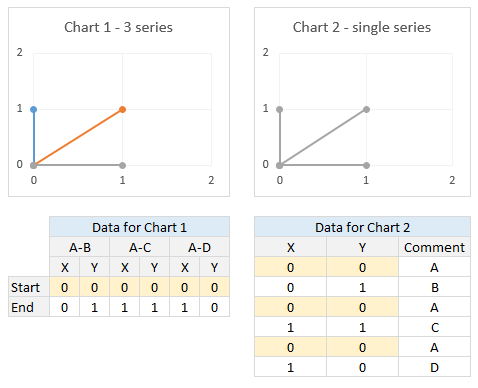
So instead of 190 series of data for the chart, we just need 20 series.
In the final chart, we actually have 40 + 2 + 1 series of data. This is because,
- 20 lines for weak relationships (dotted lines)
- 20 lines for strong relationships (thick lines)
- 1 line for highlighted person’s weak relationships
- 1 line for highlighted person’s strong relationships
- 1 set of no line & just dots for the people
How to generate all the 20 series of data:
This requires following logic:
- Assuming we need lines for the relationship of person n.
- That person’s dot location will be (Xn, Yn) and already calculated earlier (in the plotting dots around circle)
- We need total of 40 rows of data
- Every odd row will have (Xn, Yn)
- For every even row
- Divide the row number by 2 to get person number (say m)
- (Xn,Yn) if there is no relationship between n and m
- (Xm,Ym) if there is a relationship
We need MOD & INDEX formulas to express this logic in Excel.
Examine the download workbook to understand how its done.
Once all the line co-ordinates are calculated, add them to our scatter plot and format.
I used a macro to automate the formatting. It can be done manually too, just takes a little patience.
Slicer for selecting a person
This works only in Excel 2010 or above.
Select the first 2 columns of relationship matrix & create a pivot table.
Now, insert a slicer on Person name column.
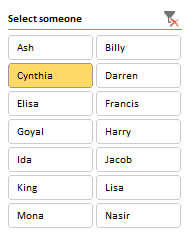
Using simple IF formula, extract the selected person name from pivot table (examine download file for the logic).
And using the name, extract the subset of line data to separate range (2 sets of data – one for weak & one for strong relationships)
Add this new data to our scatter plot and format.
Format the slicer (using slicer styles) so that it looks slick.
Related: formatting slicers using styles.
NOTE About Slicers: If you change or add any data, you must refresh (from Data ribbon) to update the slicer. This can be automated with a macro, but I want to keep this file macro free.
[Alternative] Selecting a person with form controls
You can use either a list box or a range of clickable cells. See the 2003 compatible download file for an example of this.
Summary statistics
Using simple formulas extract statistics for the selected person and show them near the chart.

Adding labels to the chart (person names)
In our chart, we are showing person names instead of regular label like X or Y value. This is done with value from cells label feature in Excel 2013.

For earlier versions of Excel, I recommend using Rob Bovey’s excellent XY Chart Labels add-in.
Putting it all together
Once everything is ready, clean up the chart, slicer and other elements, put them together. And we are ready to go.
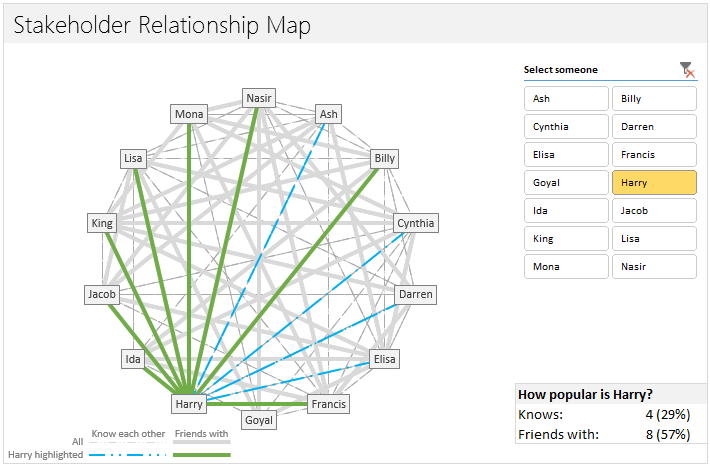
Download Network Relationships Interactive Chart Template
Click here to download the chart template workbook. The download is a ZIP file and it contains 3 workbooks – compatible with Excel 2013, 2010 & 2003+. Use the version that you need.
Please examine the formulas & chart settings to understand how it is constructed.
Note: Hit Refresh from Data ribbon to change slicer once you have added or modified data.
When to use network relationship chart?
A network graph is a good place to explore relationships between people in a project or team. It is especially useful when selecting a sub-set of people from large group to closely work on a project.
Any alternatives?
There is a popular Excel Add-in named NodeXL that can help you visualize and analyze relationships between people in a more in-depth fashion.
Check out Chord diagram & Cosmograph from E90E50 site for other ways to present this data.
Do you use these kind of charts?
I have used network charts earlier to depict relationships between various people or things. But I have never created such charts in Excel, I always used either Power Point or some other drawing program to create them. That is why I am excited about this chart. Figuring out the formula & graphing logic was fun.
What about you? Have you used such charts before? How do you like the network chart presented here? Please share your thoughts using comments.




















One Response to “How to export YouTube video comments to Excel file? – Free template + Power Query case study”
And I asked myself when i saw your Accouncement Video for the Give away: "Seriously, will Chandoo go manualy thru all his Videos and pick the winners?!". Great connection to the give away with this tutorial 🙂 !